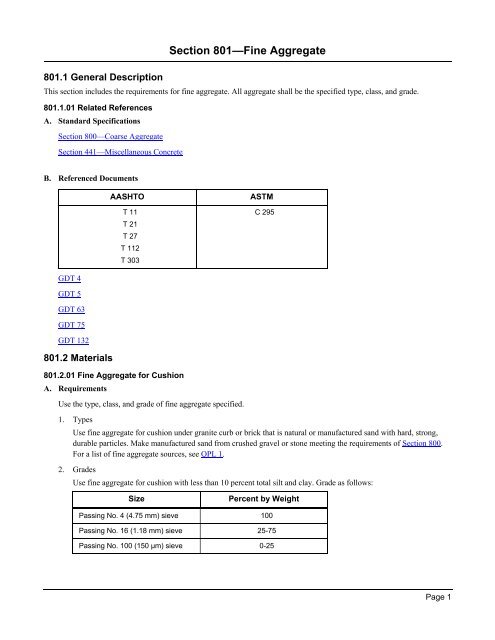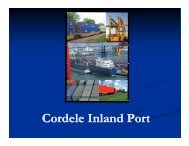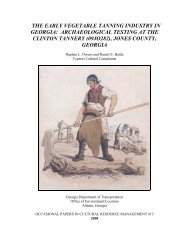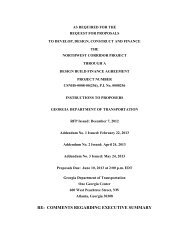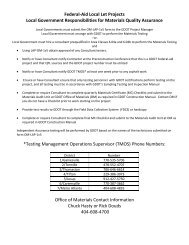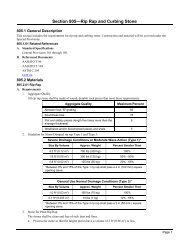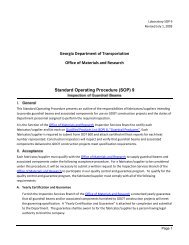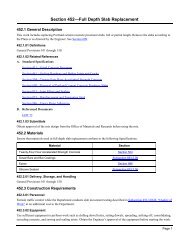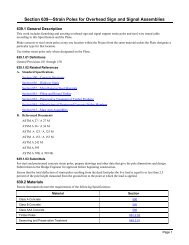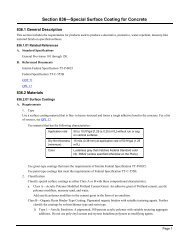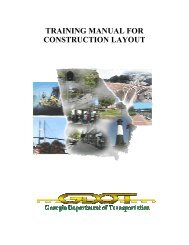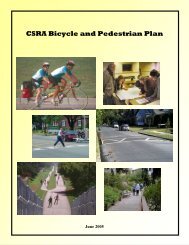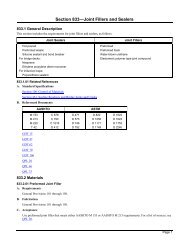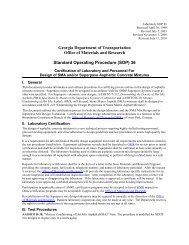Section 801 Fine Aggregate
Section 801 Fine Aggregate
Section 801 Fine Aggregate
You also want an ePaper? Increase the reach of your titles
YUMPU automatically turns print PDFs into web optimized ePapers that Google loves.
<strong>Section</strong> <strong>801</strong>—<strong>Fine</strong> <strong>Aggregate</strong><strong>801</strong>.1 General DescriptionThis section includes the requirements for fine aggregate. All aggregate shall be the specified type, class, and grade.<strong>801</strong>.1.01 Related ReferencesA. Standard Specifications<strong>Section</strong> 800—Coarse <strong>Aggregate</strong><strong>Section</strong> 441—Miscellaneous ConcreteB. Referenced DocumentsAASHTOT 11T 21T 27T 112T 303ASTMC 295GDT 4GDT 5GDT 63GDT 75GDT 132<strong>801</strong>.2 Materials<strong>801</strong>.2.01 <strong>Fine</strong> <strong>Aggregate</strong> for CushionA. RequirementsUse the type, class, and grade of fine aggregate specified.1. TypesUse fine aggregate for cushion under granite curb or brick that is natural or manufactured sand with hard, strong,durable particles. Make manufactured sand from crushed gravel or stone meeting the requirements of <strong>Section</strong> 800.For a list of fine aggregate sources, see QPL 1.2. GradesUse fine aggregate for cushion with less than 10 percent total silt and clay. Grade as follows:SizePercent by WeightPassing No. 4 (4.75 mm) sieve 100Passing No. 16 (1.18 mm) sieve 25-75Passing No. 100 (150 µm) sieve 0-25Page 1
<strong>Section</strong> <strong>801</strong>—<strong>Fine</strong> <strong>Aggregate</strong>B. FabricationGeneral Provisions 101 through 150.C. AcceptanceTest as follows:Sieve analysis—AASHTO T 27D. Materials WarrantyGeneral Provisions 101 through 150.<strong>801</strong>.2.02 <strong>Fine</strong> <strong>Aggregate</strong> for Portland Cement Concrete of All Types and for MortarA. Requirements1. Concrete and MortarUse fine aggregate for concrete and mortar that consists of natural sand, manufactured sand, or blends of natural andmanufactured sands, having hard, clean, strong, durable, uncoated particles, meeting the requirements of theSpecifications.2. Manufactured SandUse manufactured sand made exclusively from crushed stone or gravel that meets <strong>Section</strong> 800 requirements.Manufactured sand used in concrete for construction of Portland cement concrete pavement, approach slabs, andbridge decks, shall be made from Group II aggregates as specified in Subsection 800.2.01.A.2.3. Miscellaneous ConcreteSand manufactured from synthetic aggregate meeting the requirements of <strong>Section</strong> 800 may be blended with naturalsands or manufactured sands made from crushed stone or gravel for use in miscellaneous concrete as described in<strong>Section</strong> 441.Blend at least 50 percent natural sand or manufactured sand made from crushed stone or gravel.4. Concrete SandConcrete sand that passes the No. 10 (2 mm) sieve shall have these characteristics:CharacteristicRequirementDurability indexSand equivalent70 or greater70 or greater5. Detrimental SubstancesKeep detrimental substances within these limits:SubstanceMaximum Percent by WeightClay lumpsCoal and ligniteAll detrimental substances (any combination)0.5 maximum in total sample0.5 maximum in total sample2.0 maximum in total sampleNOTE: Do not use fine aggregate in Portland cement concrete that is capable of producing a deleterious reactionwith Portland cementProvided the material passing the No. 16 (1.18 mm) sieve is petrographically determined to be essentially free ofdetrimental substances, test results for coal and lignite and other detrimental substances listed will be basedupon a petrographic analysis of material retained on the No. 16 (1.18 mm) sieve.Page 2
<strong>Section</strong> <strong>801</strong>—<strong>Fine</strong> <strong>Aggregate</strong>Calculations will be based upon the weighted average for the total sample.Other detrimental substances include constituents such as shale, weathered or decomposed rock, soft or friableparticles, coated grains, or other substances that might be considered detrimental for the use intended.6. Organic Impurities (natural sands only)Ensure all fine aggregate is free from detrimental amounts of organic impurities.Do not use materials that have colorimetric test (AASHTO T 21) results darker than the Reference Standard colorplate.7. GradesGrade fine aggregates for Portland cement concrete and mortar as follows:Size No. Description Total Percent by Weight Passing Each Sieve3/ 8 in(9.5 mm)No. 4(4.75 mm)No. 16(1.18 mm)No. 50(300 µm)No. 100(150 µm)No. 200(75 µm)10 NS Natural concrete sand 100 95-100 45-95 8-30 1-10 0-320 NS Natural mortar sand 100 100 90-100 15-50 0-15 0-510 SM Standard manufactured concrete sand 100 95-100 45-95 8-30 1-10 0-410 FM <strong>Fine</strong> manufactured concrete sand 100 95-100 45-95 15-42 8-22 3-9B. FabricationGeneral Provisions 101 through 150.C. AcceptanceTest as follows:TestMethodPetrographic analysis ASTM C 295Material that passes a No. 200 (75 µm) sieve AASHTO T 11Organic impurities AASHTO T 21Sieve analysis AASHTO T 27Sand equivalent GDT 63Reactivity AASHTO T 303Durability index GDT 75Clay lumps AASHTO T 112Friable Particles GDT 132NOTE: The percent passing the No. 200 sieve (75 µm) for size 10FM will be based upon the total percent determinedby AASHTO T-11 and AASHTO T-27. The percent passing the No. 200 sieve (75 µm) for sizes 10NS, 20NS and10SM will be as determined by AASHTO T-11 only.D. Materials WarrantyGeneral Provisions 101 through 150.Page 3
<strong>Section</strong> <strong>801</strong>—<strong>Fine</strong> <strong>Aggregate</strong><strong>801</strong>.2.03 <strong>Fine</strong> <strong>Aggregate</strong> for Sand Cement Rip RapA. Requirements1. Make fine aggregate for sand cement rip rap out of hard, durable particles without detrimental amounts of organicimpurities.2. Material that passes the No. 10 (2 mm) sieve shall contain less than 7 percent clay and have less than 20 percent thatpasses the No. 200 (75 µm) sieve.3. The Engineer may allow up to 30 percent by weight of the material retained on the No. 4 (4.75 mm) sieve if:B. FabricationThe aggregate still meets the intended purpose.All of the particles pass the 3 in (75 mm) sieve.General Provisions 101 through 150.C. AcceptanceThe Department will conduct laboratory tests to determine whether or not the material reacts favorably with Portlandcement. If it does not, the Department will reject it, even though it may meet the other requirements.The Department will use the following tests:TestMethodSoil gradation GDT 4Portland cement reaction GDT 5D. Materials WarrantyGeneral Provisions 101 through 150.Page 4


